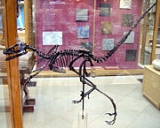
2000 in paleontology
Encyclopedia
Newly named insects
| Name | Status | Authors | Age | Unit | Location | Notes | Images |
|---|---|---|---|---|---|---|---|
Baltocteniza Baltocteniza Baltocteniza is an extinct monotypic genus of trapdoor spider in the Ctenizidae subfamily Ctenizinae and at present, it contains the single species Baltocteniza kulickae... |
Valid |
|
Early Eocene (Miocene Miocene The Miocene is a geological epoch of the Neogene Period and extends from about . The Miocene was named by Sir Charles Lyell. Its name comes from the Greek words and and means "less recent" because it has 18% fewer modern sea invertebrates than the Pliocene. The Miocene follows the Oligocene... ) |
Baltic amber Baltic amber The Baltic region is home to the largest known deposit of amber, called Baltic amber or succinite, with about 80% of the world's known amber found there. It dates from 44 million years ago... |
The type and only species is Baltocteniza kulickae Europe Europe |
||
Electrocteniza Electrocteniza Electrocteniza is an extinct monotypic genus of Trapdoor spider in the Ctenizidae subfamily Ctenizinae and at present, it contains the single species Electrocteniza sadilenkoi... |
Valid |
|
Early Eocene (Miocene Miocene The Miocene is a geological epoch of the Neogene Period and extends from about . The Miocene was named by Sir Charles Lyell. Its name comes from the Greek words and and means "less recent" because it has 18% fewer modern sea invertebrates than the Pliocene. The Miocene follows the Oligocene... ) |
Baltic amber Baltic amber The Baltic region is home to the largest known deposit of amber, called Baltic amber or succinite, with about 80% of the world's known amber found there. It dates from 44 million years ago... |
The type and only species is Electrocteniza sadilenkoi Europe Europe |
Newly named placoderms
| Name | Status | Authors | Age | Unit | Location | Notes | Images |
|---|---|---|---|---|---|---|---|
Aleosteus Aleosteus Aleosteus is an extinct genus of arthrodire placoderm. Its fossils have been found in Sevy Dolomite Formation, in the Egan Range of east-central Nevada, USA. Almost complete fossils belong to juvenile and adult specimens and show a short and broad skull, posteriorly concave.... |
Valid |
|
Lower Devonian |
Sevy Dolomite Formation |
 United States United States |
The type species is Aleosteus eganensis. |
|
Amphibians
| Name | Status | Authors | Age | Unit | Location | Notes | Images |
|---|---|---|---|---|---|---|---|
Avitabatrachus Avitabatrachus Avitabatrachus uliana is the single species in the extinct genus Avitabatrachus, a genus of prehistoric frogs that lived in the Middle Cretaceous. Fossils of A. uliana were found in north-west Patagonia in Argentina... |
Valid |
|
Middle Cretaceous |
Candeleros Formation Candeleros Formation The Candeleros Formation is a geologic formation that outcrops in Río Negro, Neuquén, and Mendoza provinces of Argentina. It is the oldest formation in the Neuquén Group and belongs to the Rio Limay Subgroup... |
 Argentina Argentina |
The type species is Avitabatrachus uliana. |
|
Banksiops Banksiops Banksiops is an extinct genus of prehistoric amphibian.-See also:* Prehistoric amphibian* List of prehistoric amphibians... |
Valid |
|
A replacement genus for Banksia Warren & Mariscano, 1998 preoccupied for arachnid Banksia Voigt & Oudermans, 1905. |
||||
Jeholotriton Jeholotriton Jeholotriton is a genus of primitive salamander from the Daohugou Beds near Daohugou village of Inner Mongolia, China.... |
Valid |
|
Early Cretaceous |
Daohugou Bed Formation |
 Mainland China Mainland China |
The type species is Jeholotriton paradoxus. |
|
Rileymillerus Rileymillerus Rileymillerus is an extinct genus of prehistoric amphibian.-See also:* Prehistoric amphibian* List of prehistoric amphibians... |
Valid |
|
Upper Triassic |
Cooper Canyon Formation Cooper Canyon Formation -Vertebrate fauna:... |
 United States United States |
The type species is Rileymillerus cosgriffi. |
|
Ichthyosaurs
| Name | Status | Authors | Age | Unit | Location | Notes | Images |
|---|---|---|---|---|---|---|---|
Aegirosaurus Aegirosaurus Aegirosaurus is an extinct genus of ophthalmosaurid ichthyosaur known from the Late Jurassic and Early Cretaceous of Europe.-Discovery and species:... |
Valid |
|
Upper Jurassic |
 Germany Germany |
The type species is Aegirosaurus leptospondylus. |
||
Callawayia Callawayia Callawayia is an extinct genus of ichthyosaur. It contains the species Callawayia neoscapularis and C. altispinus.... |
Valid |
|
Upper Triassic |
Pardonet Formation |
 Canada Canada |
A new genus for “Shastasaurus” neoscapularis. |
|
Guizhouichthyosaurus Guizhouichthyosaurus Guizhouichthyosaurus is a genus of Ichthyosaur which existed during the lower Carnian stage of the Late Triassic in southwest China. In contains the species Guizhouichthyosaurus tangae. It had been referred to the genus Shastasaurus in the past, but later study showed that it is likely distinct,... |
Valid |
|
Upper Triassic |
Falang Formation |
 Mainland China Mainland China |
The type species is Guizhouichthyosaurus tangae. |
|
Phantomosaurus Phantomosaurus Phantomosaurus is an extinct genus of Ichthyosaur, which existed during the late Anisian period. Fossils of the species Phantomosaurus neubigi have been found in southern Germany.... |
Valid |
|
Middle Triassic |
Upper Muschelkalk Formation |
 Germany Germany |
A new genus for "Shastasaurus" neubigi. |
Newly named crurotarsans
| Name | Status | Authors | Age | Unit | Location | Notes | Images |
|---|---|---|---|---|---|---|---|
Adzhosuchus Adzhosuchus Adzhosuchus is an extinct genus of crocodylomorph in the family Shartegosuchidae. Fossils have been found from southwestern Mongolia that date back to the Late Jurassic period.... |
Valid |
|
Late Jurassic |
Shar Teg Beds |
 Mongolia Mongolia |
A basal crocodylomorph. The type species is Adzhosuchus fuscus. |
|
Kyasuchus Kyasuchus Kyasuchus is an extinct genus of shartegosuchid crocodylomorph. Fossils have been found from the Ilek Formation outcropping in the Kemerovo Oblast of Russia, deposited during the Aptian and Albian stages of the Early Cretaceous... |
Valid |
|
Early Cretaceous |
Ilek Formation |
 Russia Russia |
A basal crocodilomorph. The type species is Kyasuchus saevi. |
|
Simosuchus Simosuchus Simosuchus is an extinct genus of notosuchian crocodylomorphs from the Late Cretaceous of Madagascar. It is named for its unusually short skull. Fully grown individuals were about in length. The type species is S. clarki, found from the Maevarano Formation in Mahajanga Province.The teeth of S... |
Valid |
|
Late Cretaceous |
Maevarano Formation Maevarano Formation The Maevarano Formation is an Upper Cretaceous sedimentary rock formation found in the Mahajanga Province of northwestern Madagascar. It is most likely Maastrichtian in age, and records a seasonal, semiarid environment with rivers that had greatly varying discharges... |
 Madagascar Madagascar |
A notosuchian. The type species is Simosuchus clarki. |
|
Stolokrosuchus Stolokrosuchus Stolokrosuchus is an extinct genus of neosuchian crocodylomorph that lived during the Early Cretaceous. Its fossils, including a skull with a long thin snout and bony knobs on the prefontals, have been found in Niger. Stolokrosuchus was described in 2000 by Hans Larsson and Boubacar Gado. The... |
Valid |
|
Early Cretaceous |
El Rhaz Formation |
 Niger Niger |
A neosuchian. The type species is Stolokrosuchus lapparenti. |
Newly named dinosaurs
Data courtesy of George OlshevskyGeorge Olshevsky
George Olshevsky is a freelance editor, writer, publisher, amateur paleontologist, and mathematician living in San Diego, California.Olshevsky maintains the comprehensive online Dinosaur Genera List...
's dinosaur genera list and Dr. Jeremy Montague's dinosaur genus database.
| Name | Status | Authors | Discovery year | Age | Unit | Location | Notes | Images |
|---|---|---|---|---|---|---|---|---|
Bambiraptor Bambiraptor Bambiraptor is a Late Cretaceous, 75 million year old, bird-like dromaeosaurid theropod dinosaur described by scientists at the University of Kansas, Yale University, and the University of New Orleans.... |
Valid |
|
Two Medicine Formation Two Medicine Formation The Two Medicine Formation is a geologic formation, or rock body, that was deposited between 83.5 ± 0.7 Ma to 70.6 ± 0.6 Ma , during Campanian time, and is located in northwestern Montana... |
 United States United States |
A very bird-like two foot long dromaeosaurid. May be a juvenile Saurornitholestes Saurornitholestes Saurornitholestes is a genus of carnivorous dromaeosaurid theropod dinosaur from the late Cretaceous of Alberta, Montana and New Mexico.... . |
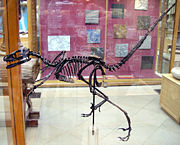   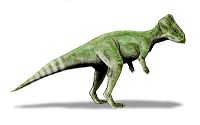 .jpg) 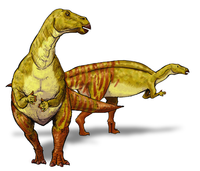 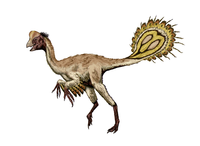 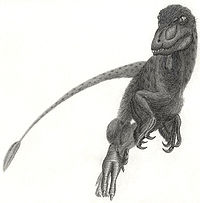  |
||
Byronosaurus Byronosaurus Byronosaurus is a genus of troodontid dinosaur which lived during the Late Cretaceous Period. It was named for Byron Jaffe, "in recognition of his family's support for the Mongolian Academy of Sciences-American Museum of Natural History Paleontological Expeditions." The first example of... |
Valid |
|
Djadochta Formation Djadochta Formation The Djadochta Formation is situated in central Asia and dates from the Late Cretaceous Period. Laid down in the early Campanian, possibly starting in the latest Santonian, it is dated somewhat uncertainly at about 84-75 mya... |
 Mongolia Mongolia |
A five foot long troodontid. Mysteriously, skulls of extremely small juveniles have been recovered from an oviraptorosaur nest. This may be evidence of brood parasitism or predator-prey relationships between the two species. |
|||
Charonosaurus Charonosaurus Charonosaurus |Charon]]'s lizard") is the name of a genus of dinosaur whose fossils were discovered by Godefroit, Zan & Jin in 2000 on the south bank of the Amur River, dividing China from Russia.-Description:... |
Valid |
|
Yuliangze Formation Yuliangze Formation The Yuliangze Formation is a geological formation in Heilongjiang, China whose strata date back to the Late Cretaceous. Dinosaur remains are among the fossils that have been recovered from the formation.-Vertebrate paleofauna:... |
 Mainland China Mainland China |
A 13 m (42.5 ft) long Parasaurolophus Parasaurolophus Parasaurolophus is a genus of ornithopod dinosaur that lived in what is now North America during the Late Cretaceous Period, about 76.5–73 million years ago. It was an herbivore that walked both as a biped and a quadruped. Three species are recognized: P. walkeri , P. tubicen, and the... -like lambeosaur. |
|||
Chuanjiesaurus Chuanjiesaurus Chuanjiesaurus was a genus of dinosaur from the Middle Jurassic Period. It lived in what is now present-day China. It is classified as a sauropod. The type species, Chuanjiesaurus ananensis, was first described by Fang, Pang, Lü, Zhang, Pan, Wang, Li and Cheng in 2000... |
Valid |
|
Chuanjie Formation Chuanjie Formation The Chuanjie Formation is a geological formation in Yunnan, China. It dates back to the Middle Jurassic.-Vertebrate fauna:... |
 Mainland China Mainland China |
A mamenchisaurid. |
|||
Fukuiraptor Fukuiraptor Fukuiraptor was a medium-sized carnivore of the Early Cretaceous that lived in what is now Japan. Scientists first thought it was a member of the Dromaeosauridae, but after studying the fossils they now believe it was related to Allosaurus in the family Neovenatoridae. The type specimen is the... |
Valid |
|
Kitadani Formation Kitadani Formation The Kitadani Formation is a geological formation in Fukui, Japan whose strata date back to the Early Cretaceous. Dinosaur remains are among the fossils that have been recovered from the formation.-Vertebrate paleofauna:... |
 Japan Japan |
A neovenatorid known only from juvenile specimens. |
|||
"Ginnareemimus Ginnareemimus Kinnareemimus is a genus of ornithomimosaurian theropod dinosaur from Thailand. It is known only from incomplete remains including vertebrae, partial pubic bones, metatarsals, and an incomplete fibula... " |
Nomen nudum Nomen nudum The phrase nomen nudum is a Latin term, meaning "naked name", used in taxonomy... |
|
Sao Khua Formation Sao Khua Formation The Sao Khua Formation is a middle member of the Khorat Group. It consists of an alteration of grayish-reddish brown siltstone and clay, and pale red to yellowish-gray, fine to medium-grained sandstone. Rare pale red to light gray conglomerates, containing carbonate pebbles, are also characteristic... |
 Thailand Thailand |
Formally named Kinnareemimus in 2009 in paleontology 2009 in paleontology -Anomalocaridids:-Arachnids:-Insects:-Cephalopods:Three new species of extinct Octopoda discovered in 2009. The species - Keuppia hyperbolaris, Keuppia levante, and Styletoctopus annae - lived about 95 million years ago, and bear a strong resemblance to modern octopuses, suggesting that the... . |
|||
Glyptodontopelta Glyptodontopelta Glyptodontopelta is a genus of dinosaur from the Late Cretaceous. It was an ankylosaur, an armored dinosaur.... |
Valid |
|
Ojo Alamo Sandstone |
 United States United States |
Named after the armored mammal Glyptodon Glyptodon Glyptodon was a large, armored mammal of the family Glyptodontidae, a relative of armadillos that lived during the Pleistocene Epoch. It was roughly the same size and weight as a Volkswagen Beetle, though flatter in shape... . |
|||
Graciliceratops Graciliceratops Graciliceratops is a Ceratopsian dinosaur first described by paleontologist Paul Sereno in 2000. It is known from the Late Cretaceous period and its fossils were found in Mongolia... |
Valid |
|
Sheeregeen Gashoon Formation |
 Mongolia Mongolia |
Primitive ceratopsian. Only a partial skeleton has been found. |
|||
Huabeisaurus Huabeisaurus Huabeisaurus was a genus of dinosaur from the Late Cretaceous . It was a sauropod which lived in what is present-day northern China. The type species, Huabeisaurus allocotus, was first described by Pang and Cheng in 2000. The dinosaur closely resembles Opisthocoelicaudia, and was a quadrupal... |
Valid |
|
Huiquanpu Formation Huiquanpu Formation The Huiquanpu Formation is a geological formation in Shanxi and Hebei provinces, China, whose strata date back to the Late Cretaceous period.Dinosaur remains are among the fossils that have been recovered from the formation.-Vertebrate paleofauna:* cf... |
 Mainland China Mainland China |
Opisthocoelicaudia Opisthocoelicaudia Opisthocoelicaudia was 12-metre-long sauropod dinosaur of the Late Cretaceous Period discovered in Mongolia in 1965 by Polish and Mongolian scientists in what is now the Gobi Desert... -like titanosaurid. |
|||
“Iguanoides” |
Nomen nudum Nomen nudum The phrase nomen nudum is a Latin term, meaning "naked name", used in taxonomy... ; synonym of Iguanodon Iguanodon Iguanodon is a genus of ornithopod dinosaur that lived roughly halfway between the first of the swift bipedal hypsilophodontids and the ornithopods' culmination in the duck-billed dinosaurs... |
Conybeare vide:
|
Junior synonym of Iguanodon Iguanodon Iguanodon is a genus of ornithopod dinosaur that lived roughly halfway between the first of the swift bipedal hypsilophodontids and the ornithopods' culmination in the duck-billed dinosaurs... . |
|||||
Ilokelesia Ilokelesia Ilokelesia is a primitive abelisaur found in 1991, preserved in the layers of the earliest Late Cretaceous of the Río Limay Formation, Neuquén Group, located near Plaza Huincul, Neuquén Province, Argentina. The specimen, consisting of very fragmentary elements of the skull, the axial and the... |
Valid |
|
Rio Limay Formation Rio Limay Formation The Rio Limay Subgroup is a geological unit in Neuquen, Argentina whose strata date back to the Late Cretaceous. Dinosaur remains are among the fossils that have been recovered from the formations it contains.... |
 Argentina Argentina |
A primitive abelisaur who name is derived from "flesh lizard" in Mapuche. |
|||
Isanosaurus Isanosaurus Isanosaurus was one of the first true sauropod dinosaurs, with all four legs always on the ground. It lived 210 million years ago in Thailand. The type species is Isanosaurus attavipachi... |
Valid |
|
Nam Phong Formation Nam Phong Formation The Nam Phong Formation is the basal unit of the Khorat Group. It consists of resistant, red-brown micaceous sandstones, conglomerates, siltstone and mudstone of mainly fluvial origin. The sandstones are medium to very fine-grained and are usually calcareous. The conglomerates contain pebbles of... |
 Thailand Thailand |
A small, 6.5 metres (21 ft) long sauropod. |
|||
Jeholosaurus Jeholosaurus Jeholosaurus is a genus of ornithischian dinosaur from the Early Cretaceous Period. It is thought to have been a small ornithopod presumably related to the hypsilophodonts, and an herbivore. Although the back teeth are like those of a plant eater, the front premaxillary teeth are sharp and pointed... |
Valid |
|
Yixian Formation Yixian Formation The Yixian Formation is a geological formation in Jinzhou, Liaoning, People's Republic of China, that spans 11 million years during the early Cretaceous period... |
 Mainland China Mainland China |
A 71.1 centimetres (28.0 in) long hypsilophodont. |
|||
Microraptor Microraptor Microraptor is a genus of small, four-winged dromaeosaurid dinosaurs. Numerous well-preserved fossil specimens have been recovered from Liaoning, China... |
Valid |
|
Jiufotang Formation Jiufotang Formation The Jiufotang Formation is an Early Cretaceous geological formation in Chaoyang, Liaoning which has yielded fossils of feathered dinosaurs, primitive birds, pterosaurs, and other organisms. . It is a member of the Jehol group. The exact age of the Jiufotang has been debated for years, with... |
 Mainland China Mainland China |
A tiny "four-winged" dromaeosaurid. |
|||
Nanyangosaurus Nanyangosaurus Nanyangosaurus is a genus of herbivorous ornithischian dinosaur from the Early Cretaceous. It was an iguanodont which lived in the area of present-day China.... |
Valid |
|
Sangping Formation Sangping Formation The Sangping Formation is a geological formation in Henan, China, whose strata date back to the Early Cretaceous. Dinosaur remains are among the fossils that have been recovered from the formation.-References:... |
 Mainland China Mainland China |
A hadrosauroid. |
|||
Nomingia Nomingia Nomingia is a genus of oviraptorid theropod dinosaur hailing from the Late Cretaceous Bugin Tsav Beds of Mongolia.-Discovery and naming:... |
Valid |
|
Beds of Bugeen Tsav |
 Mongolia Mongolia |
The first non-avian dinosaur known to have a pygostyle at the end of its tail. In life this structure probably supported a fan of feathers. |
|||
Nqwebasaurus Nqwebasaurus Nqwebasaurus is the name given to a genus of dinosaur from the Tithonian to Valanginian . It was a basal coelurosaur related to Ornitholestes. Its fossils were found in South Africa in the Kirkwood Formation, which is called Nqweba in the native language of the Xhosa... |
Valid |
|
Kirkwood Formation Kirkwood Formation The Kirkwood Formation is a geological formation in Eastern Cape and Western Cape provinces, South Africa whose strata date back to the Early Cretaceous... |
 South Africa South Africa |
The earliest known coelurosaur from Gondwana, the type specimen was a three foot long juvenile with preserved gastroliths in its stomach. |
|||
"Ponerosteus Ponerosteus Ponerosteus is a dubious genus of archosaur which was first identified as "Iguanodon exogirarum" by Antonin Fritsch in 1878 for a specimen from the Cenomanian . He later renamed it Procerosaurus, unaware that this name was already in use... " |
Nomen dubium Nomen dubium In zoological nomenclature, a nomen dubium is a scientific name that is of unknown or doubtful application... ; possibly non-dinosaurian |
|
A dubious taxon whose name means "useless bone" to reflect the low quality of the material, which had fueled taxonomic confusion. |
|||||
Pyroraptor Pyroraptor Pyroraptor is a genus of dromaeosaurid dinosaur from the late Cretaceous Period of France. It is known from a single specimen. It was found in 1992 in the south of France, in Provence, and is known only from a few bones. It was named Pyroraptor olympius by Allain and Taquet in 2000. The name means... |
Valid |
|
Grès à Reptiles Grès à Reptiles Grès à Reptiles is a French fossil site in the département of Var preserving the remains of several types of dinosaurs and other extinct organisms.-Vertebrate paleofauna:... |
 Early Modern France Early Modern France |
A dromaeosaurid known from a single specimen. |
|||
| Rocasaurus Rocasaurus Rocasaurus is a genus of titanosaurian sauropod that lived in South America about 80 million years ago, during the Late Cretaceous. This genus grew up to 8 meters long, making it one of the smaller sauropods... |
Valid |
|
Allen Formation Allen Formation The Allen Formation is a geological formation in Argentina whose strata date back to the Late Cretaceous The Allen Formation is a geological formation in Argentina whose strata date back to the Late Cretaceous The Allen Formation is a geological formation in Argentina whose strata date back to the... |
 Argentina Argentina |
A small, 8 meter long titanosaur. |
|||
“Saltriosaurus Saltriosaurus Saltriosaurus is the informal name for a theropod dinosaur that lived during the Jurassic period. It was found in 1996, when Angelo Zanella discovered its remains in a quarry in Saltrio, in northern Italy. Very little is known about the dinosaur... ” |
Nomen nudum Nomen nudum The phrase nomen nudum is a Latin term, meaning "naked name", used in taxonomy... |
|
An Allosaurus Allosaurus Allosaurus is a genus of large theropod dinosaur that lived 155 to 150 million years ago during the late Jurassic period . The name Allosaurus means "different lizard". It is derived from the Greek /allos and /sauros... -like theropod estimated to be 8 meters (26 ft) long. Only ten percent of its skeleton is known. |
|||||
Sauroposeidon Sauroposeidon Sauroposeidon is a genus of sauropod dinosaur known from four neck vertebrae that were found in the southeastern portion of the US state of Oklahoma. The fossils were found in rocks dating to the Early Cretaceous, a period when the sauropods of North America had diminished in both size and... |
Valid |
|
Antlers Formation Antlers Formation The Antlers Formation occurs as a band of strata from Arkansas through southern Oklahoma into northeastern Texas. It consists of 150 m of silty to sandy mudstones, fine- to coarse grained sandstones that are poorly to moderately sorted and cemented with clay or calcium carbonate... |
 United States United States |
A gigantic brachiosaur with an estimated length of up to 34 m (112 ft) and a mass of 50–60 t (55–66 short tons). It is known from four neck vertebrae. |
|||
Tendaguria Tendaguria Tendaguria is a genus of sauropod dinosaur from the Late Jurassic of Tanzania.It was a large sauropod from the Tendaguru fossil locality in Tanzania; based on two anterior dorsal vertebrae from Nambango, 15 kilometers southeast of Tendaguru Hill, Tanzania, probably in the Upper... |
Valid |
|
Tendaguru Formation |
 Tanzania Tanzania |
A 20 meters (66 ft) long sauropod. |
|||
Newly named birds
| Name | Status | Authors | Age | Unit | Location | Notes | Images |
|---|---|---|---|---|---|---|---|
Protopteryx Protopteryx Protopteryx is an extinct genus of bird, perhaps an enantiornithine, from the Cretaceous in China. The type species is P. fengningensis... |
Valid |
|
Early Cretaceous |
Huajiying Formation Huajiying Formation The Huajiying Formation is a geological formation in Hebei, People's Republic of China. Known for its fossils including primitive birds, the age of the ormation is uncertain. It may represent an early portion of the Jehol Biota, dating to somewhere in the early Cretaceous or late Jurassic periods... |
 Mainland China Mainland China |
An enanthornithine. The type species is Protopteryx fengningensis. |
|
Newly named pterosaurs
| Name | Status | Authors | Age | Unit | Location | Notes | Images |
|---|---|---|---|---|---|---|---|
Domeykodactylus Domeykodactylus Domeykodactylus was a genus of dsungaripterid pterodactyloid pterosaur from the Early Cretaceous-age Quebrada de la Carreta of Antofagasta, Chile.... |
Valid |
|
Early Cretaceous |
Santa Ana Formation |
 Chile Chile |
A pterodactyloid. The type species is Domeykodactylus ceciliae. |
|
Anhanguera piscator |
Valid |
|
Early Cretaceous |
Santana Formation Santana Formation The Santana Formation is a geologic Lagerstätte in northeastern Brazil's Araripe Basin where the states of Pernambuco, Piauí and Ceará come together. The geological formation, named after the village of Santana do Cariri, lies at the base of the Araripe Plateau... |
 Brazil Brazil |
A pterodactyloid. Reclassified in 2006 to the genus Coloborhynchus Coloborhynchus Coloborhynchus is a genus in the pterosaur family Ornithocheiridae, and is known from the Lower Cretaceous of England , and possibly the Aptian age of Brazil and Texas, depending on which species are included.-Description:The type specimen of Coloborhynchus is known only from a partial upper jaw... . |
Non-mammalian
| Name | Status | Authors | Age | Unit | Location | Notes | Images |
|---|---|---|---|---|---|---|---|
Australobarbarus Australobarbarus Australobarbarus is a genus of dicynodont from Late Permian of Russia.... |
Valid |
|
Upper Permian |
Sokolki Faunal Assemblage |
 Russia Russia |
A dicynodont Dicynodont Dicynodontia is a taxon of anomodont therapsids or mammal-like reptiles. Dicynodonts were small to large herbivorous animals with two tusks, hence their name, which means 'two dog tooth'... . Two species are described Australobarbarus kotelnitshi (type) and A. platycephalus. |
|
Charruodon Charruodon Charruodon tetracuspidatus is an extinct species of synapsid which existed in Geopark of Paleorrota, Brazil during the middle–late Triassic period. It is placed in its own genus, Charruodon. Only one specimen is known, and is of uncertain provenance.... |
Valid |
|
Upper Triassic |
Santa Maria Formation Santa Maria Formation The Santa Maria Formation is a sedimentary rock formation found in Rio Grande do Sul, Brazil. It has a late Ladinian – early Carnian age , and is notable for its fossils of early dinosaurs, including the herrerasaur Staurikosaurus, the basal saurischian Teyuwasu, and the basal sauropodomorph... |
 Brazil Brazil |
A cynodont Cynodont Cynodontia or cynodonts are a taxon of therapsids which first appeared in the Late Permian and were eventually distributed throughout all seven continents by the Early Triassic . This clade includes modern mammals and their extinct close relatives. They were one of the most diverse groups of... . The type species Type species In biological nomenclature, a type species is both a concept and a practical system which is used in the classification and nomenclature of animals and plants. The value of a "type species" lies in the fact that it makes clear what is meant by a particular genus name. A type species is the species... is Charruodon tetracuspidatus. |
|
Chlynovia Chlynovia Chlynovia is an extinct genus of therocephalian therapsid from the Late Permian of Russia. The type species is C. serridentatus, named in 2000. Chlynovia was originally classified within Scaloposauria, a group of therocephalians characterized by their small size and lightly built skulls... |
Valid |
|
Upper Permian |
Sokolki Faunal Assemblage |
 Russia Russia |
A therocephalian. The type species is Chlynovia serridentatus. |
|
Dadadon Dadadon Dadadon is a traversodontid cynodont which existed in Madagascar during the late Middle Triassic. The only species in the genus is Dadadon isaloi.... |
Valid |
|
Middle-Upper Triassic |
Makay Formation |
 Madagascar Madagascar |
An eucynodont. The type species is Dadadon isaloi. |
|
Menadon Menadon Menadon is an extinct genus of synapsid which existed in Madagascar during the middle to late Triassic period. The type species is Menadon besairiei.... |
Valid |
|
Middle-Upper Triassic |
Makay Formation |
 Madagascar Madagascar |
A eucynodont. The type species is Menodon besairiei. |
|
Nikkasaurus Nikkasaurus Nikkasaurus is an extinct genus of therapsid.They were small animals, with skulls about 5 cm long. Their eyes had large orbits and sclerotic rings... |
Valid |
|
Upper Permian |
Mezen Faunal Assemblage |
 Russia Russia |
A nikkasaurid. The type species is Nikkasaurus tatarinovi. |
|
Reiszia Reiszia Reiszia is an extinct genus of non-mammalian synapsid.-References:*... |
Valid |
|
Upper Permian |
Mezen Faunal Assemblage |
 Russia Russia |
A nikkasaurid. Two species are described Reiszia gubini (type) and R. tippula. |
|
Scalopodontes Scalopodontes Scalopodontes is an extinct genus of synapsid which existed in Russia during the upper Permian period. It contains the species Scalopodontes kotelnichi.... |
Valid |
|
Upper Permian |
Sokolki Faunal Assemblage |
 Russia Russia |
A theriocephalian. The type species is Scalopodontes kotelnichi |
|
Suchogorgon Suchogorgon Suchogorgon is an extinct genus of therapsid.... |
Valid |
|
Upper Permian |
Sokolki Faunal Assemblage |
 Russia Russia |
A gorgonopsid. The type species is Suchogorgon golubevi. |
|
Vivaxosaurus Vivaxosaurus Vivaxosaurus is a genus of dicynodont from Late Permian of Russia.... |
Valid |
|
Upper Permian |
Sokolki Faunal Assemblage |
 Russia Russia |
A dicynodont. The type species is Vivaxosaurus permicus. |

